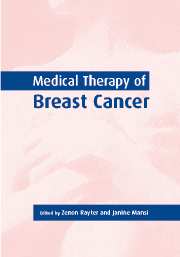Book contents
- Frontmatter
- Contents
- List of contributors
- 1 History of breast cancer therapy
- 2 Chemoprevention of breast cancer
- 3 Familial breast cancer
- 4 Hormone replacement therapy and breast cancer
- 5 Screening for breast cancer
- 6 The management of in situ breast cancer
- 7 Adjuvant systemic therapy
- 8 Adjuvant radiotherapy in the management of breast cancer
- 9 Predictors of response and resistance to medical therapy
- 10 Primary medical therapy in breast cancer
- 11 Medical therapy of advanced disease
- 12 Experimental approaches
- 13 The place of bisphosphonates in the management of breast cancer
- 14 Palliative care in breast cancer
- Index
14 - Palliative care in breast cancer
Published online by Cambridge University Press: 06 January 2010
- Frontmatter
- Contents
- List of contributors
- 1 History of breast cancer therapy
- 2 Chemoprevention of breast cancer
- 3 Familial breast cancer
- 4 Hormone replacement therapy and breast cancer
- 5 Screening for breast cancer
- 6 The management of in situ breast cancer
- 7 Adjuvant systemic therapy
- 8 Adjuvant radiotherapy in the management of breast cancer
- 9 Predictors of response and resistance to medical therapy
- 10 Primary medical therapy in breast cancer
- 11 Medical therapy of advanced disease
- 12 Experimental approaches
- 13 The place of bisphosphonates in the management of breast cancer
- 14 Palliative care in breast cancer
- Index
Summary
Introduction
Chemotherapy and radiotherapy are probably the most effective means of palliation in metastatic breast cancer, but inevitably there will come a time when these modalities are no longer appropriate or possible to deliver. The emphasis must then be on pain and symptom control with the aim of maximizing quality of life.
Metastatic breast cancer is a chronic disease of relapse and recurrence, almost invariably ending in death. Although symptom care or palliative care tends to be positioned at the end of any schema documenting the management of advanced breast disease, this input should be available from the start, throughout the disease course and not just in the terminal phase. It is important that the transition from active anticancer treatment to palliative care is seamless for both the patient and her family (Royal College of Radiologists Clinical Information Network, 1999) (Figure 14.1). Moreover, the ideal palliative care model is interdisciplinary whereby the identity of the team is more important than the individuals in it. This is in contrast to the more traditional medical multidisciplinary team where the individuals are known more by their personal expertise and secondarily by their team affliation (Cummings, 1998).
This chapter deals with the management of the common symptoms in women with metastatic breast cancer. These symptoms can often be directly related to the characteristic patterns of disease spread. Wherever possible, data has been taken from recent reviews or controlled studies. There is a paucity of evidence in palliative care however (Higginson, 1999), and much of the practice is based on personal experience and anecdotal evidence.
- Type
- Chapter
- Information
- Medical Therapy of Breast Cancer , pp. 357 - 385Publisher: Cambridge University PressPrint publication year: 2003



